2007 CHEVROLET CORVETTE warning
[x] Cancel search: warningPage 355 of 488
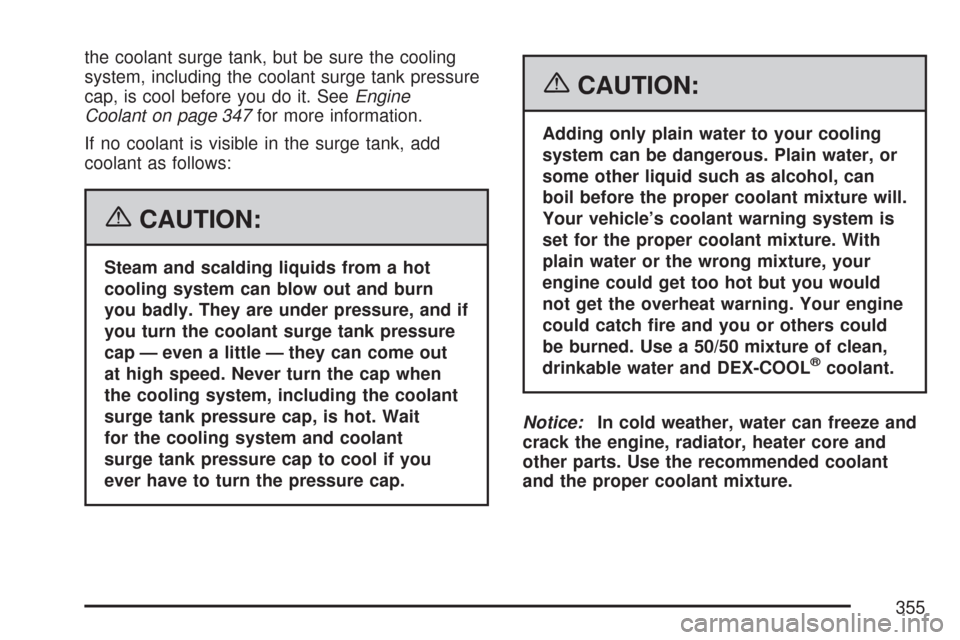
the coolant surge tank, but be sure the cooling
system, including the coolant surge tank pressure
cap, is cool before you do it. SeeEngine
Coolant on page 347for more information.
If no coolant is visible in the surge tank, add
coolant as follows:
{CAUTION:
Steam and scalding liquids from a hot
cooling system can blow out and burn
you badly. They are under pressure, and if
you turn the coolant surge tank pressure
cap — even a little — they can come out
at high speed. Never turn the cap when
the cooling system, including the coolant
surge tank pressure cap, is hot. Wait
for the cooling system and coolant
surge tank pressure cap to cool if you
ever have to turn the pressure cap.
{CAUTION:
Adding only plain water to your cooling
system can be dangerous. Plain water, or
some other liquid such as alcohol, can
boil before the proper coolant mixture will.
Your vehicle’s coolant warning system is
set for the proper coolant mixture. With
plain water or the wrong mixture, your
engine could get too hot but you would
not get the overheat warning. Your engine
could catch �re and you or others could
be burned. Use a 50/50 mixture of clean,
drinkable water and DEX-COOL
®coolant.
Notice:In cold weather, water can freeze and
crack the engine, radiator, heater core and
other parts. Use the recommended coolant
and the proper coolant mixture.
355
Page 363 of 488
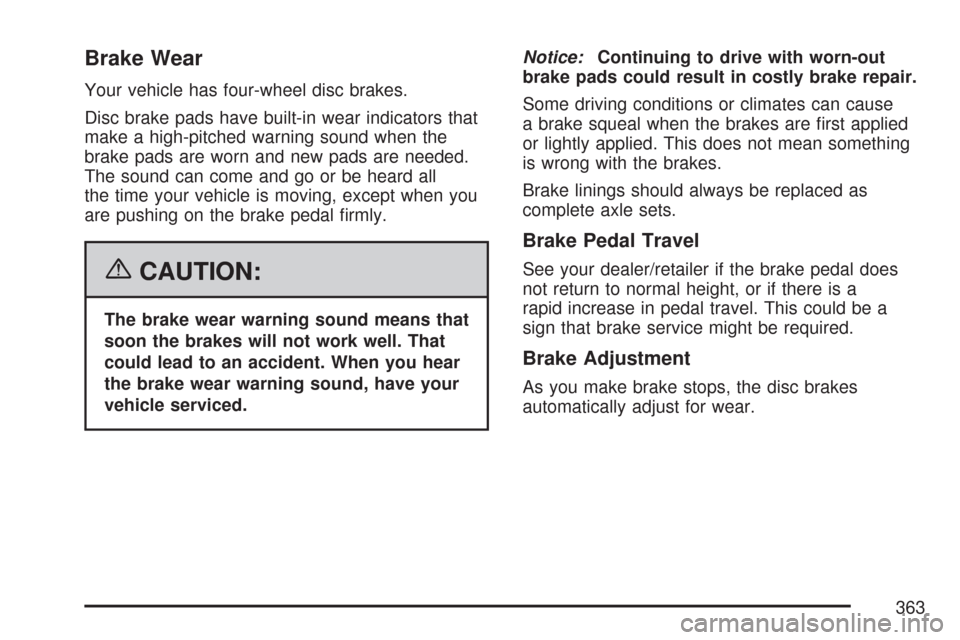
Brake Wear
Your vehicle has four-wheel disc brakes.
Disc brake pads have built-in wear indicators that
make a high-pitched warning sound when the
brake pads are worn and new pads are needed.
The sound can come and go or be heard all
the time your vehicle is moving, except when you
are pushing on the brake pedal �rmly.
{CAUTION:
The brake wear warning sound means that
soon the brakes will not work well. That
could lead to an accident. When you hear
the brake wear warning sound, have your
vehicle serviced.Notice:Continuing to drive with worn-out
brake pads could result in costly brake repair.
Some driving conditions or climates can cause
a brake squeal when the brakes are �rst applied
or lightly applied. This does not mean something
is wrong with the brakes.
Brake linings should always be replaced as
complete axle sets.
Brake Pedal Travel
See your dealer/retailer if the brake pedal does
not return to normal height, or if there is a
rapid increase in pedal travel. This could be a
sign that brake service might be required.
Brake Adjustment
As you make brake stops, the disc brakes
automatically adjust for wear.
363
Page 364 of 488
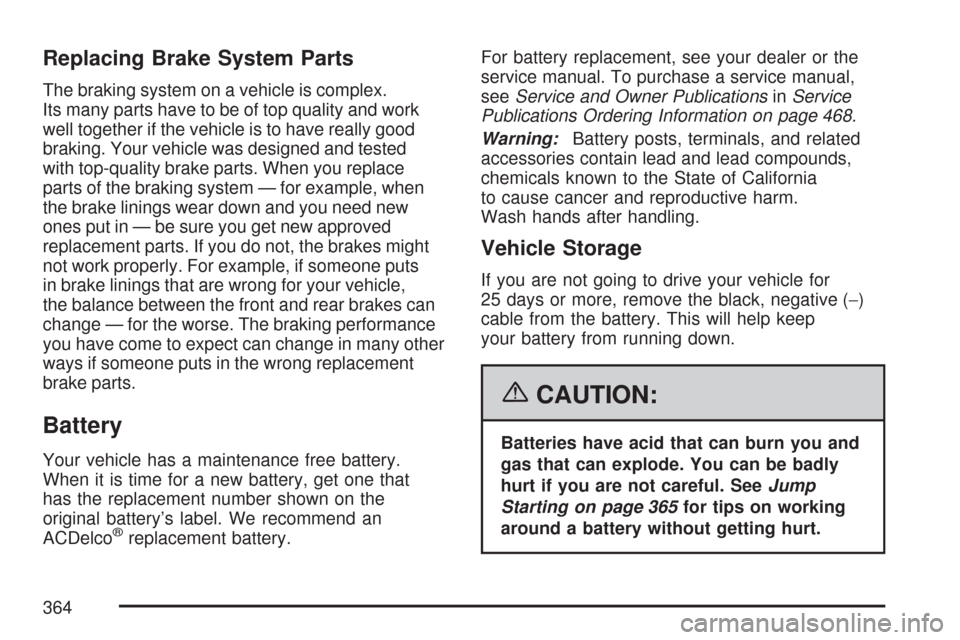
Replacing Brake System Parts
The braking system on a vehicle is complex.
Its many parts have to be of top quality and work
well together if the vehicle is to have really good
braking. Your vehicle was designed and tested
with top-quality brake parts. When you replace
parts of the braking system — for example, when
the brake linings wear down and you need new
ones put in — be sure you get new approved
replacement parts. If you do not, the brakes might
not work properly. For example, if someone puts
in brake linings that are wrong for your vehicle,
the balance between the front and rear brakes can
change — for the worse. The braking performance
you have come to expect can change in many other
ways if someone puts in the wrong replacement
brake parts.
Battery
Your vehicle has a maintenance free battery.
When it is time for a new battery, get one that
has the replacement number shown on the
original battery’s label. We recommend an
ACDelco
®replacement battery.For battery replacement, see your dealer or the
service manual. To purchase a service manual,
seeService and Owner PublicationsinService
Publications Ordering Information on page 468.
Warning:Battery posts, terminals, and related
accessories contain lead and lead compounds,
chemicals known to the State of California
to cause cancer and reproductive harm.
Wash hands after handling.
Vehicle Storage
If you are not going to drive your vehicle for
25 days or more, remove the black, negative (−)
cable from the battery. This will help keep
your battery from running down.
{CAUTION:
Batteries have acid that can burn you and
gas that can explode. You can be badly
hurt if you are not careful. SeeJump
Starting on page 365for tips on working
around a battery without getting hurt.
364
Page 389 of 488
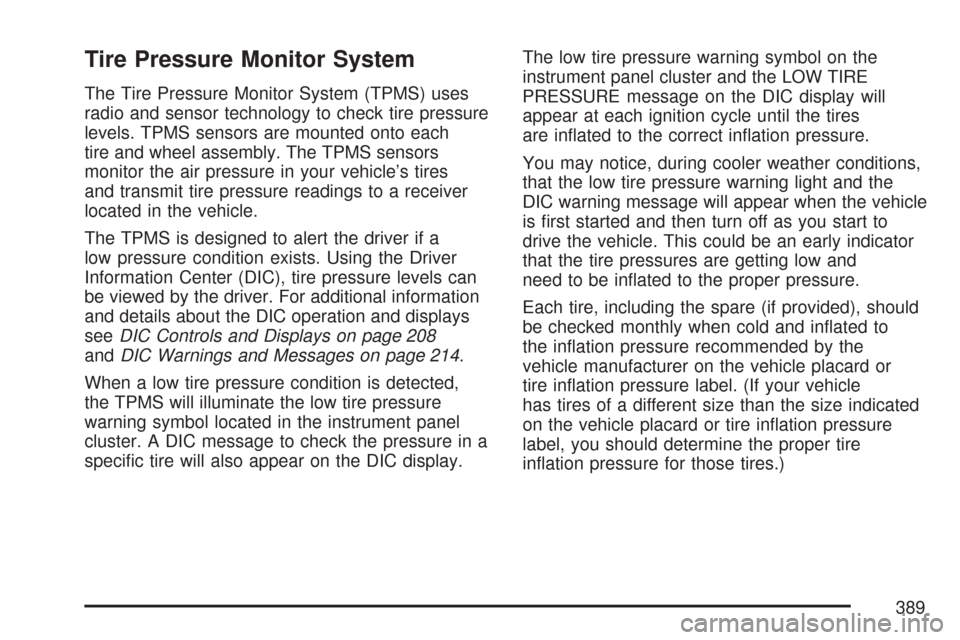
Tire Pressure Monitor System
The Tire Pressure Monitor System (TPMS) uses
radio and sensor technology to check tire pressure
levels. TPMS sensors are mounted onto each
tire and wheel assembly. The TPMS sensors
monitor the air pressure in your vehicle’s tires
and transmit tire pressure readings to a receiver
located in the vehicle.
The TPMS is designed to alert the driver if a
low pressure condition exists. Using the Driver
Information Center (DIC), tire pressure levels can
be viewed by the driver. For additional information
and details about the DIC operation and displays
seeDIC Controls and Displays on page 208
andDIC Warnings and Messages on page 214.
When a low tire pressure condition is detected,
the TPMS will illuminate the low tire pressure
warning symbol located in the instrument panel
cluster. A DIC message to check the pressure in a
speci�c tire will also appear on the DIC display.The low tire pressure warning symbol on the
instrument panel cluster and the LOW TIRE
PRESSURE message on the DIC display will
appear at each ignition cycle until the tires
are in�ated to the correct in�ation pressure.
You may notice, during cooler weather conditions,
that the low tire pressure warning light and the
DIC warning message will appear when the vehicle
is �rst started and then turn off as you start to
drive the vehicle. This could be an early indicator
that the tire pressures are getting low and
need to be in�ated to the proper pressure.
Each tire, including the spare (if provided), should
be checked monthly when cold and in�ated to
the in�ation pressure recommended by the
vehicle manufacturer on the vehicle placard or
tire in�ation pressure label. (If your vehicle
has tires of a different size than the size indicated
on the vehicle placard or tire in�ation pressure
label, you should determine the proper tire
in�ation pressure for those tires.)
389
Page 395 of 488
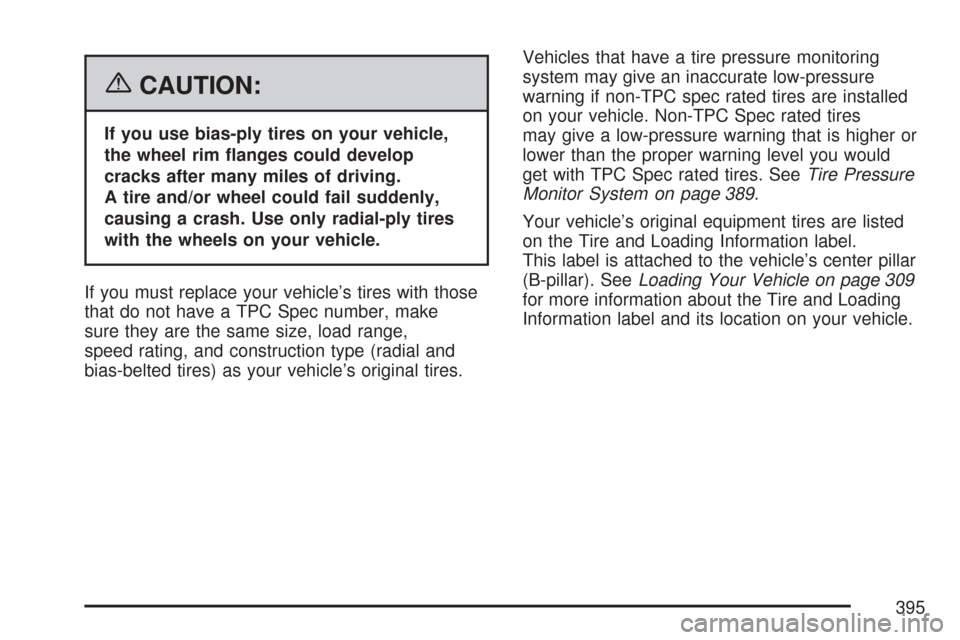
{CAUTION:
If you use bias-ply tires on your vehicle,
the wheel rim �anges could develop
cracks after many miles of driving.
A tire and/or wheel could fail suddenly,
causing a crash. Use only radial-ply tires
with the wheels on your vehicle.
If you must replace your vehicle’s tires with those
that do not have a TPC Spec number, make
sure they are the same size, load range,
speed rating, and construction type (radial and
bias-belted tires) as your vehicle’s original tires.Vehicles that have a tire pressure monitoring
system may give an inaccurate low-pressure
warning if non-TPC spec rated tires are installed
on your vehicle. Non-TPC Spec rated tires
may give a low-pressure warning that is higher or
lower than the proper warning level you would
get with TPC Spec rated tires. SeeTire Pressure
Monitor System on page 389.
Your vehicle’s original equipment tires are listed
on the Tire and Loading Information label.
This label is attached to the vehicle’s center pillar
(B-pillar). SeeLoading Your Vehicle on page 309
for more information about the Tire and Loading
Information label and its location on your vehicle.
395
Page 397 of 488
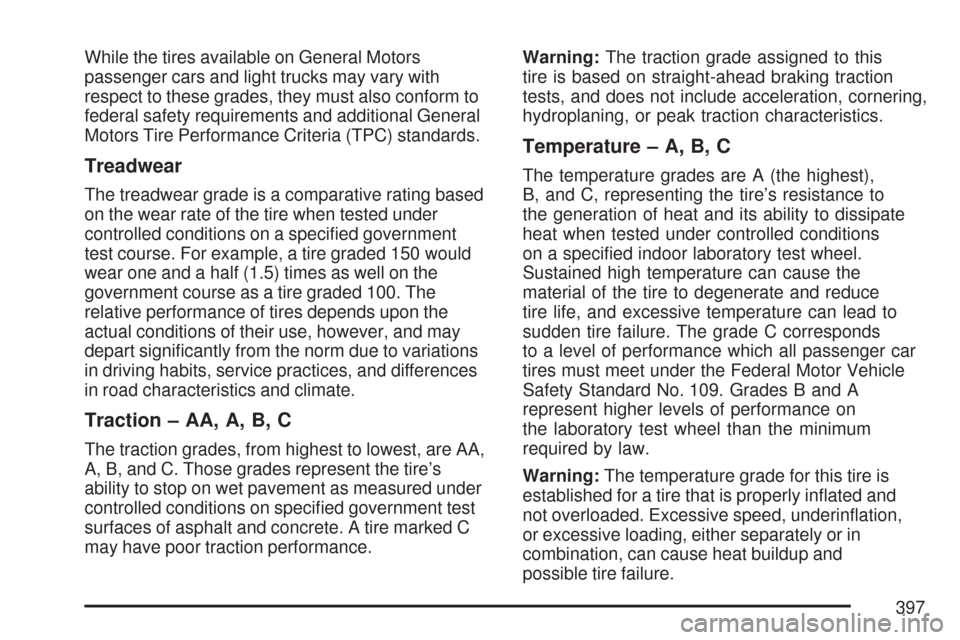
While the tires available on General Motors
passenger cars and light trucks may vary with
respect to these grades, they must also conform to
federal safety requirements and additional General
Motors Tire Performance Criteria (TPC) standards.
Treadwear
The treadwear grade is a comparative rating based
on the wear rate of the tire when tested under
controlled conditions on a speci�ed government
test course. For example, a tire graded 150 would
wear one and a half (1.5) times as well on the
government course as a tire graded 100. The
relative performance of tires depends upon the
actual conditions of their use, however, and may
depart signi�cantly from the norm due to variations
in driving habits, service practices, and differences
in road characteristics and climate.
Traction – AA, A, B, C
The traction grades, from highest to lowest, are AA,
A, B, and C. Those grades represent the tire’s
ability to stop on wet pavement as measured under
controlled conditions on speci�ed government test
surfaces of asphalt and concrete. A tire marked C
may have poor traction performance.Warning:The traction grade assigned to this
tire is based on straight-ahead braking traction
tests, and does not include acceleration, cornering,
hydroplaning, or peak traction characteristics.
Temperature – A, B, C
The temperature grades are A (the highest),
B, and C, representing the tire’s resistance to
the generation of heat and its ability to dissipate
heat when tested under controlled conditions
on a speci�ed indoor laboratory test wheel.
Sustained high temperature can cause the
material of the tire to degenerate and reduce
tire life, and excessive temperature can lead to
sudden tire failure. The grade C corresponds
to a level of performance which all passenger car
tires must meet under the Federal Motor Vehicle
Safety Standard No. 109. Grades B and A
represent higher levels of performance on
the laboratory test wheel than the minimum
required by law.
Warning:The temperature grade for this tire is
established for a tire that is properly in�ated and
not overloaded. Excessive speed, underin�ation,
or excessive loading, either separately or in
combination, can cause heat buildup and
possible tire failure.
397
Page 473 of 488
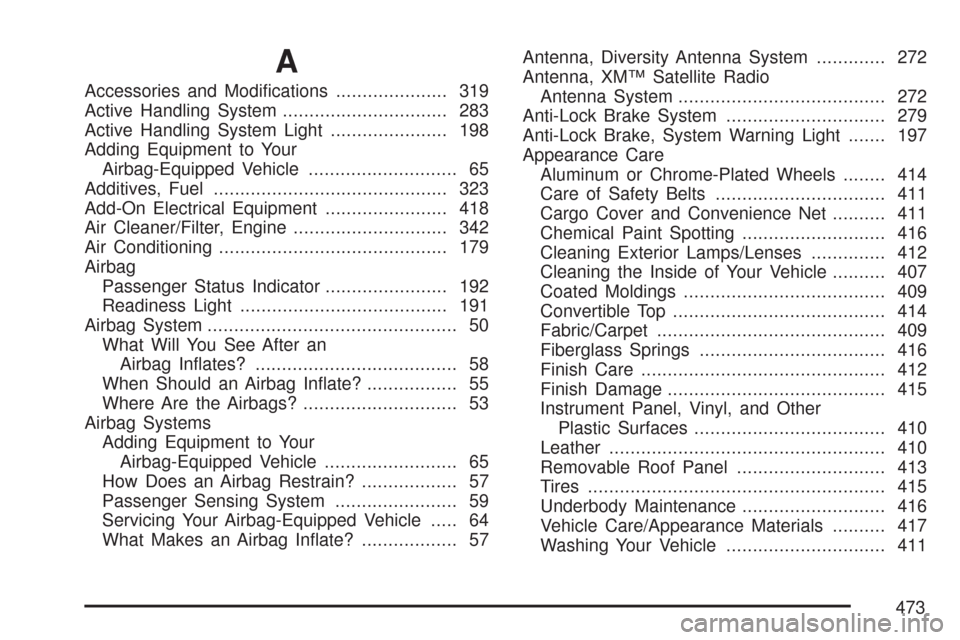
A
Accessories and Modi�cations..................... 319
Active Handling System............................... 283
Active Handling System Light...................... 198
Adding Equipment to Your
Airbag-Equipped Vehicle............................ 65
Additives, Fuel............................................ 323
Add-On Electrical Equipment....................... 418
Air Cleaner/Filter, Engine............................. 342
Air Conditioning........................................... 179
Airbag
Passenger Status Indicator....................... 192
Readiness Light....................................... 191
Airbag System............................................... 50
What Will You See After an
Airbag In�ates?...................................... 58
When Should an Airbag In�ate?................. 55
Where Are the Airbags?............................. 53
Airbag Systems
Adding Equipment to Your
Airbag-Equipped Vehicle......................... 65
How Does an Airbag Restrain?.................. 57
Passenger Sensing System....................... 59
Servicing Your Airbag-Equipped Vehicle..... 64
What Makes an Airbag In�ate?.................. 57Antenna, Diversity Antenna System............. 272
Antenna, XM™ Satellite Radio
Antenna System....................................... 272
Anti-Lock Brake System.............................. 279
Anti-Lock Brake, System Warning Light....... 197
Appearance Care
Aluminum or Chrome-Plated Wheels........ 414
Care of Safety Belts................................ 411
Cargo Cover and Convenience Net.......... 411
Chemical Paint Spotting........................... 416
Cleaning Exterior Lamps/Lenses.............. 412
Cleaning the Inside of Your Vehicle.......... 407
Coated Moldings...................................... 409
Convertible Top........................................ 414
Fabric/Carpet........................................... 409
Fiberglass Springs................................... 416
Finish Care.............................................. 412
Finish Damage......................................... 415
Instrument Panel, Vinyl, and Other
Plastic Surfaces.................................... 410
Leather.................................................... 410
Removable Roof Panel............................ 413
Tires........................................................ 415
Underbody Maintenance........................... 416
Vehicle Care/Appearance Materials.......... 417
Washing Your Vehicle.............................. 411
473
Page 474 of 488
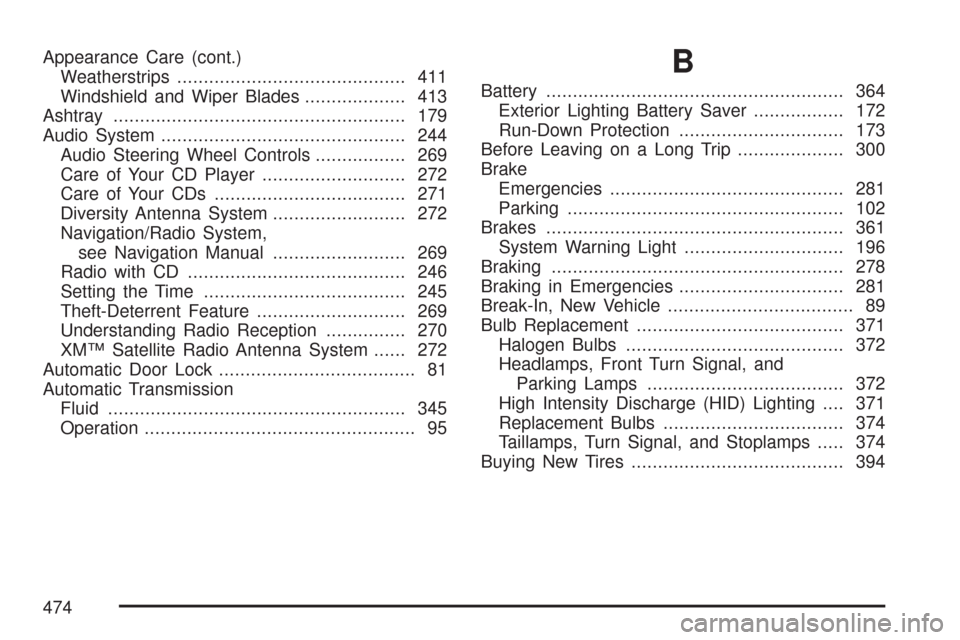
Appearance Care (cont.)
Weatherstrips........................................... 411
Windshield and Wiper Blades................... 413
Ashtray....................................................... 179
Audio System.............................................. 244
Audio Steering Wheel Controls................. 269
Care of Your CD Player........................... 272
Care of Your CDs.................................... 271
Diversity Antenna System......................... 272
Navigation/Radio System,
see Navigation Manual......................... 269
Radio with CD......................................... 246
Setting the Time...................................... 245
Theft-Deterrent Feature............................ 269
Understanding Radio Reception............... 270
XM™ Satellite Radio Antenna System...... 272
Automatic Door Lock..................................... 81
Automatic Transmission
Fluid........................................................ 345
Operation................................................... 95B
Battery........................................................ 364
Exterior Lighting Battery Saver................. 172
Run-Down Protection............................... 173
Before Leaving on a Long Trip.................... 300
Brake
Emergencies............................................ 281
Parking.................................................... 102
Brakes........................................................ 361
System Warning Light.............................. 196
Braking....................................................... 278
Braking in Emergencies............................... 281
Break-In, New Vehicle................................... 89
Bulb Replacement....................................... 371
Halogen Bulbs......................................... 372
Headlamps, Front Turn Signal, and
Parking Lamps..................................... 372
High Intensity Discharge (HID) Lighting.... 371
Replacement Bulbs.................................. 374
Taillamps, Turn Signal, and Stoplamps..... 374
Buying New Tires........................................ 394
474